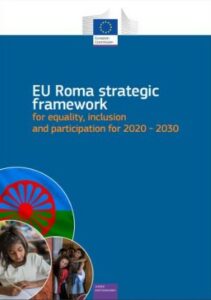EU Roma Strategic Framework for Equality, Inclusion and Participation for 2020-2030 sets more ambitious, measurable targets focusing on inclusion, antigypsyism and negative effect of COVID19.
Vice-President Vĕra JOUROVÁ and Commissioner Helena DALLI publicly presented the EC proposal for a EU Roma Strategic Framework for Equality, Inclusion and Participation for 2020-2030 with the ambition that the next 10 years it will make a difference and reduce the inequality gap. A new Council Recommendation is expected in the coming months.

The Framework package includes a Portfolio of indicators coordinated by the European Agency for Fundamental Rights (FRA) and an Analytical Document where use of ESI Funds such as ESF+ or ERDF are highly recommended to support and add value to Member States Policies on equality for Roma population.
Previous EU framework 2011-2020 had had limited positive impact in the living conditions of Roma. Extremely high levels of poverty, discrimination, unequal access to education, employment, health or housing opportunities are still a too wide inequality gap in comparison with overall population, which has been even worsened with the impact of COVID19.
The framework intends to address Roma inequality within EU through focusing on equality, inclusion and participation as horizontal objectives with measurable targets, oriented to change our mindset, combat prejudices and fight antigyspsyism and discrimination
Education, employment, health and housing, remain core areas to be targeted by Member States through their National Roma Strategies, but three capital objectives are now included to be monitored and taken into action by MS: effective equality, Roma people effective and meaningful participation and socio-economic inclusion fighting persisting poverty rates.
The establishment of quantifiable targets per key area and the inclusion of every two-years follow-up process to measures the specific progress made by Member States are a significant step forward that will surely press Member States to efficiently invest on Roma and reduce inequality and poverty rates.
Complementarity of ESI funds, such as ESF+ under its Specific Objective (viiia) Promoting socio-economic integration of marginalised communities such as the Roma and ERDF, under Specific Objective 4.3, Increasing the socioeconomic integration of marginalized communities, migrants and disadvantaged groups, through integrated measures including housing and social services are to be considered by Member States when designing their National Strategic Policy Frameworks, due by September 2021. By funding through EU funds both targeted and mainstreamed measures, Member States can secure long term actions, both at national and regional level to foster Roma Population equality for the next period.
The European Framework allows Member States to better programming a long-term strategy to address Roma inequality regarding socioeconomic rights such as housing, employment, (with special attention to Youth Employment and NEET rate reduction), access to health and education. But also, it allows to take ambitious measures regarding antidiscrimination and fight against antigypsyism, poverty reduction and enhance meaningful participation of Roma Population.
A more relevant position is also given to National Roma Contact Points and Equality Bodies, to be engaged in monitoring the accomplishment of targets and following up national policies.
Alignment and complementarity with other EU Policy Strategies such as the Gender Equality Strategy, the Anti-Discrimination Action Plan, the Strategy on Social Inclusion and the European Pillar of Social Rights must be taken into account when Member States will design their National Strategic Policy Framework for Roma Equality for the coming 10 years period.

